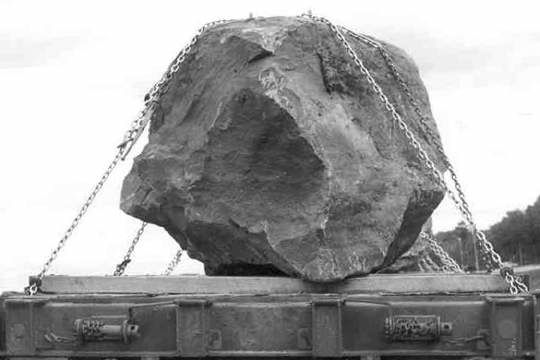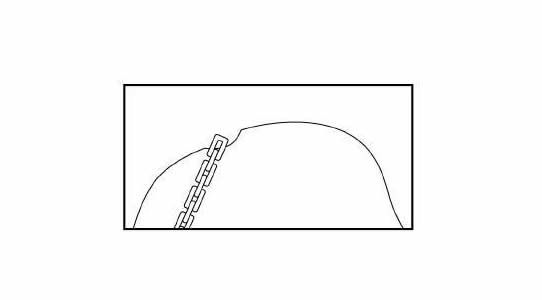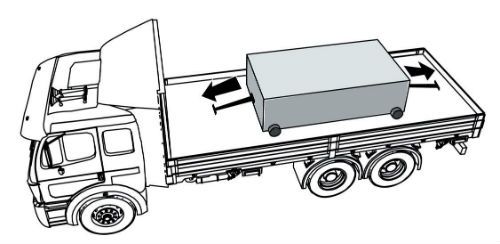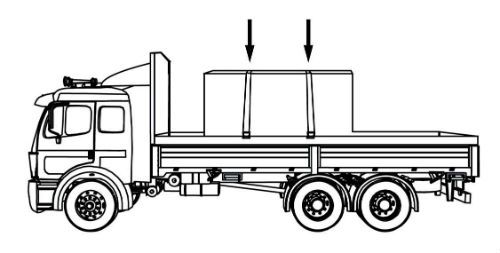CDL Practice Tests: Flatbed Cargo Securement
Choose A Section:
Go!While driving, the freight must not:
- All of these things should be avoided.
- Obscure the driver's view ahead, left, or right.
- Prevent the exit of a person from the cab.
- Interfere with the free movement of the driver's arms or legs.
- Obscure the driver's view ahead or to the right or left sides (except for drivers of self-steer dollies).
- Interfere with the free movement of the driver's arms or legs.
- Prevent the driver's free and ready access to accessories required for emergencies. OR
- Prevent the free and ready exit of any person from the commercial motor vehicle's cab or driver's compartment.
Within the requirements for concrete pipe, which of these requires specific securement methods?
- Concrete pipe that is grouped together into a single rigid article and may not roll.
- Concrete pipe loaded in a sided vehicle or container.
- Concrete pipe eyes vertical and concrete pipe loaded lengthwise.
- Concrete pipe loaded cross-wise on a flatbed trailer.
What is exempt from these specific requirements?
Follow general cargo securement requirements (Section 2) when transporting the following pipe:
- Concrete pipe that is grouped together into a single rigid article and may not roll.
- Concrete pipe loaded in a sided vehicle or container.
- Concrete pipe eyes vertical and concrete pipe loaded lengthwise.
What is covered under these specific requirements?
Any concrete pipe loaded crosswise on a platform trailer or vehicle that is not exempt.
If you were instructed to 'tarp' a load, what would you be using?
- A platform or tray on which cargo is placed so that it can be handled as an article.
- A waterproof sheet used to cover cargo.
- A strip of material that may be used to unitize articles and is tensioned and clamped or crimped back upon itself.
- A short piece of material, usually wood, nailed to the deck to reinforce blocking.
Tarp:
A waterproof sheet used to cover cargo.
When securing concrete pipe over 45 inches loaded crosswise, which direction must the tiedowns on the front half of the load run?
- It doesn't matter
- Forward
- Straight up and down
- Rearward
Requirements for securing the pipe
Secure each pipe with tiedowns through the pipe.
Run at least one tiedown through each pipe in the front half of the load. This includes the middle one if there are an odd number. The tiedown must run rearward at an angle not more than 45° with the horizontal when viewed from the side of the vehicle, whenever practicable.
Run at least one tiedown through each pipe in the rear half of the load. The tiedown must run forward at an angle not more than 45° with the horizontal when viewed from the side of the vehicle, whenever practicable. This holds each pipe firmly in contact with adjacent pipe.
What is the presumed resistance to horizontal movement of friction mats?
- 100% of cargo weight.
- 20% of cargo weight.
- 0
- 50% of cargo weight.
Note: Friction mats, which are not marked by the manufacturer, are assumed to provide a resistance to horizontal movement equal to 50% of the cargo weight that is resting on the mat.
The North American Cargo Securement Standard cover vehicles weighing:
- Over 4,500 lbs
- 26,001 lbs
- Over 10,000 lbs
- Less than 10,000 lbs
North American Cargo Securement Standard
What does the Standard cover? (Section 1.1)
- Commercial vehicles (including a combination of vehicles) that are operated on a highway and have a gross vehicle rating over 4,500 kg (10,000 lb.)
Vehicles
What is the minimum amount of rearward force that a cargo securement system must withstand?
- 100% of cargo weight
- 20% of cargo weight
- 50% of cargo weight
- 80% of cargo weight
Each cargo securement system must be able to withstand a minimum amount of force in each direction.
- Forward Force = 80% of cargo weight when braking while driving straight ahead.
- Rearward Force = 50% of cargo weight when accelerating, shifting gears while climbing a hill, or braking in reverse.
- Sideways Force = 50% of cargo weight when turning, changing lanes, or braking while turning.
-
Upward Force = 20% of cargo weight when traveling over bumps in the road or cresting a hill.
- This requirement is satisfied when the cargo is "Fully Contained."
When using tiedowns to secure boulders, all of the following are requirements except:
- Tiedowns should be located in valleys or notches across the top of the boulder.
- Tiedowns must be arranged to prevent sliding across the rock surface.
- Boulders must be loaded as far back towards the rear as possible.
- Use only chain to secure large boulders.
Requirements

Use only chain to secure large boulders.
Tiedowns in direct contact with the boulder:

Should be located in valleys or notches across the top of the boulder
Must be arranged to prevent sliding across the rock surface.
In cargo securement, what is a 'cleat' defined as?
- A tapered or wedge-shaped piece used to secure round articles against rolling.
- Part of the structure, fitting, or attachment on a vehicle or cargo to which a tiedown is attached.
- A tapered piece of material, thick at one end and thin at the other.
- A short piece of material, usually wood, nailed to the deck to reinforce blocking.
Cleat:
A short piece of material, usually wood, nailed to the deck to reinforce blocking.
A bulkhead is defined as:
- A vertical barrier placed directly behind the cab of a tractor to protect the cab in the event cargo should shift forward.
- A structure, device, or another substantial article placed against or around an article to prevent horizontal movement of the article.
- A vertical barrier across the front of the deck of a vehicle to prevent forward movement of cargo.
- A vertical barrier across a vehicle to prevent forward movement of cargo.
Bulkhead:
A vertical barrier across a vehicle to prevent forward movement of cargo.
About The Flatbed Cargo Securement CDL Manual
Studying the flatbed cargo securement CDL manual is not a requirement for getting your CDL permit or license. It is required knowledge for flatbed drivers.
Some questions you should be able to answer for flatbed cargo securement:
- What is the minimum Working Load Limit of a tiedown used to secure logs?
- What is the minimum weight of a shipment of paper rolls that would require specific securement requirements?
- When securing concrete pipe over 45 inches loaded crosswise, which direction must the tiedowns on the front half of the load run?
- What is a cab shield?
- When securing concrete pipe over 45 inches loaded crosswise, which direction must the tiedowns on the rear half of the load run?
- What is a dunnage bag?
- Who is responsible for inspecting securing devices and cargo within the first 50 miles?
- How many tiedowns are required on a stack of shortwood loaded crosswise?
- What is the minimum working load limit of each tiedown used to secure crushed or flattened vehicles?
- Define 'bolster'
- What is a hook-lift container?
- When a tiedown is attached directly to the cargo, what is the ideal angle where it attached to the vehicle?
What is a securing device?
Any device specifically manufactured to attach or secure cargo to a vehicle or trailer:
- Synthetic Webbing
- Chain
- Wire rope
- Manila rope
- Synthetic rope
- Steel strapping
- Clamps and latches
- Blocking
- Front-end structure
- Grab hooks
- Binders
- Shackles
- Winches
- Stake pockets
- D-rings
- Webbing ratchet
- Bracing
- Friction mat
What is a tiedown?
A combination of securing devices that forms an assembly that:
- Attaches cargo to, or restrains cargo on a vehicle.
- Is attached to anchor point(s).

Some tiedowns are attached to the cargo and provide direct resistance to restrain the cargo from movement.

Some tie-downs pass over or through the cargo. They create a downward force that increases the effect of friction between the cargo and the deck. This friction restrains the cargo.
 Related Cargo Securement Terms That Every Driver Should Know:
Related Cargo Securement Terms That Every Driver Should Know:
-
Tiedown:
A combination of securing devices which form an assembly that attaches cargo to, or restrains cargo on, a vehicle or trailer, and is attached to anchor point(s).
-
Contained:
Cargo is contained if it fills a sided vehicle, and every article is in contact with or sufficiently close to a wall or other articles so that it cannot shift or tip if those other articles are also unable to shift or tip.
-
Blocking:
A structure, device, or another substantial article placed against or around an article to prevent horizontal movement of the article.
How should tiedowns be attached?
Tiedowns can be used in two ways:
-
Attached to the cargo:
- Tiedowns attached to the vehicle and attached to the cargo.
- Tiedowns attached to the vehicle, pass through or aroundan article of cargo, and then are attached to the vehicle again.
-
Pass over the cargo:
- Tiedowns attached to the vehicle, passed over the cargo, and then attached to the vehicle again.
Tiedown placement:

Place the tiedown as close as possible to the spacer.
Position the tiedowns as symetrically as possible over the length of the article.

Position the tiedowns to preserve the integrity of the article.







 TT On Facebook
TT On Facebook